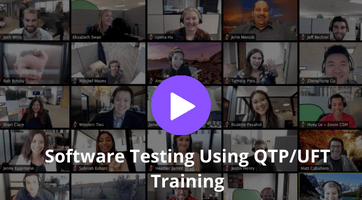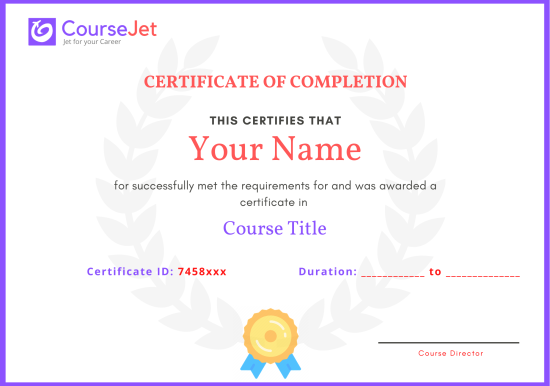Module 01 : Overview of “Automation Testing”
- Introduction to Automation Testing Tool-UFT
- Automation Tool (UFT) Architecture
- Environment supported by UFT
- Test Automation Process and Methodology
- POC in Test Automation (Proof of Concept)
- UFT Performance Improvement Tips
- How to identify the Test Case for Automation
- Object Identification Issue with UFT
- Best Practice to implement Automation Process in Software Industry
Module 02 : Automation Basics
- Object
- Properties
- Method
- Introduction to Web Objects
- Introduction to Expert & Keyword View
- Record & Play
- Recording Mode (Normal|Analog|Low Level)
- Running Mode (Fast |Normal|Debug|Maintenance|Update Mode)
- Introduction to all UFT Tabs & Short Cut Keys
Module 03 : Object Repository
- Local Object Repository
- Shared Object Repository
- Object Repository Manager
- Merging Object Repository
- Compare Object Repository
- Associate different Repositories with Test
- Associating Object Repositories with an Action
Module 04 : Object Spy
- Test Object Properties & Methods
- GetROProperty & GetTOProperty
- Run Time Object Properties & Methods
Module 05 : VB Script Basics
- VB Script Data Types & Variables and Constants
- Programming Loops & Array (Static Array & Dynamic Array)
- VB Script Built-In Functions
- VB Script User Defined Functions, Procedures & Subroutines
- VB Script Objects
- VB Script Statements
- VB Script Fundamentals & Features
Module 06 : Parameterization
- Data Table
- Xls file using DataTable.Import
- Excel Object Model
- Environment Variables
- Random Number Generator
- Global Dictionary Objects
Module 07 : UFT Checkpoint
UFT inbuilt Checkpoint
- Standard Checkpoints
- Text Checkpoints
- Text Area Checkpoints
- Bitmap Checkpoints
- Database Checkpoints
- Accessibility Checkpoints
- Xml Checkpoints (Application Area)
- Xml Checkpoints (Resource File)
Custom Checkpoints
Module 08 : Function Libraries used in UFT
- vbs File
- qfl File
- txt File
- Associate Function Library : Using AOM (Automation Object Model)
- Associate Function Library : Using ExecuteFile Method
- Associate Function Library : Using LoadFunctionLibrary Method
- Associate Function Library : Using ‘File > Settings > Resources > Associate Function Library’ option from the Menu bar
Module 09 : Objects Identification Mechanism by UFT
Module 10 : Tune UFT to work with AUT (Application under Test)
Module 11 : Actions
- Create New Action
- Call to Existing Action
- Call to Copy Action
- Associate Action with Test on Run Time using LoadAndRunAction
- Split Action
Module 12 : Object Model
- Test Object Model (TOM)
- Automation Object Model (AOM)
- Component Object Model (COM)
- Document Object Model (DOM)
Module 13 : Advanced Concepts about Synchronization
- Exist
- Wait
- Sync
- WaitProperty
- Object.ReadyState
Module 14 : UFT Settings
- Action Level Setting
- Test Level Setting
- UFT Level Setting
Module 15 : Recovery Scenario & Error Handling
- UFT inbuilt Recovery Scenario Wizard
- If…Else loop
- Error Object
- On Error Resume Next
Module 16 : UFT & ALM Connectivity
Module 17 : FSO (File System Object)
- Working with files and folders
- Create, Open, Append and Delete
Module 18 : UFT Advance Topics
- Reporter Event
- Relative Path
- Open Application using UFT
- Close Application using UFT
Module 19 : Descriptive Programming
- Using Real Objects Run Time Property (attribute/)
- Static DP
- Dynamic DP
- Hybrid DP
Module 20 : Smart Identification Mechanism
Module 21 : Debugging of UFT Script
Module 22 : Overview of Test Setting & Options Dialog Box
Module 23 : Introduction to Reserved Objects provided by UFT to make the script more generic
Module 24 : Advance Concept about Regular Expression
Module 25 : Handling of “Dynamic Objects”
- Using Object Identification Setting
- Descriptive Programming (DP) using “Run Time”/ “Test Object” Properties
- Using Recovery Scenario Wizard
Module 26 : Concept of “Virtual Object”
- Using OR Approach
- Using DP Approach
Module 27 : Database Connectivity
- Create Dynamic Database Connection
- Working with Excel as Database (ADODB connection with Excel)
Module 28 : Component Object Model (COM)
- Implementation of ‘Excel Object Model’
- Implementation of ‘Outlook Object Model’
- Implementation of ‘Word Object Model’
- .INI Files
Module 29 : File System Object – FSO
- Working with Text Files
- Working with Folders
- Working with Drives
- Create low level results using file system object
Module 30 : Difference between Test Object & Real Object
Module 31 : Windows Shell Scripting using WSH
- Send Keyboard Input to Application
- Update Windows Registry
- Methods: Run & AppActivate etc
Module 32 : Some UFT Advance Concepts
- Mercury.DeviceReplay” for “Keyboard” and “Mouse” oriented operations
- Relative Path
- Path Finder
- Advantage of Register User Function
- Custom Replay Solutions
- Web Replay Type
- Image Comparison
- RegisterUserFunction
Module 33 : Customization of UFT Results
- Using Reporter Event
- Embed Html in UFT Test Result


